National Rail NR class
The NR class are a class of Australian diesel locomotive built by A Goninan & Co for National Rail between 1996 and 1998. They are currently operated by Pacific National. The C44aci model locomotives built by UGL Rail at Broadmeadow adopted the design from the NR Class.
| National Rail NR class | |||||||||||||||||||||||||
|---|---|---|---|---|---|---|---|---|---|---|---|---|---|---|---|---|---|---|---|---|---|---|---|---|---|
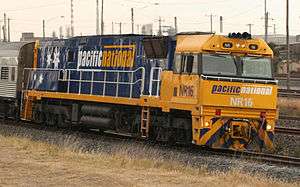 NR16 in Pacific National livery | |||||||||||||||||||||||||
| |||||||||||||||||||||||||
| |||||||||||||||||||||||||
| |||||||||||||||||||||||||
| |||||||||||||||||||||||||
History
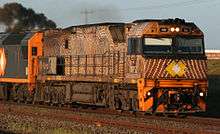

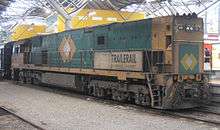
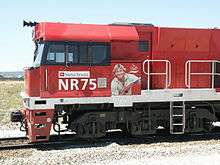
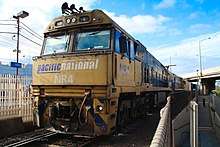
When National Rail commenced operations in April 1993, they inherited a diverse collection of rolling stock to operate interstate freight operations in Australia.[1] The fleet included locomotives of mixed age and power leased from FreightCorp, V/Line and Australian National.
In September 1995 A Goninan & Co were awarded a contract for 120 locomotives from National Rail which were built at their Broadmeadow (NR1-NR60) and Bassendean (NR61-NR120) factories.[2][3] The frames were built at Hexham and the bogies at Goninan's Landsdowne Engineering subsidiary in Taree.[2][3]
The first locomotive to be completed was NR61 which performed its first trial on 18 September 1996 between Midland and Jumpakine.[4] The first Broadmeadow built unit first ran on 23 September 1996.[4] The first units were delivered without National Rail branding or logos, but later units were delivered in full livery. Testing of the units was carried out on the NSW Main Northern line between Werris Creek and Maitland using ballast wagons and 442 class locomotives in dynamic braking mode as dynamic loads.[5] Each locomotive was required to accumulate 10,000 km of trouble free running before acceptance.[2] In February 1998 Broadmeadow delivered the last NR class.
As part of its contract, A Goninan & Co was required to maintain the fleet. A depot was built alongside the Newport to Sunshine railway in the western Melbourne suburb of Spotswood for this.[2][3]
Into service
With the arrival of the class, National Rail was able to return leased units to their owners, including 422, 80, 81, and 82 class locomotives to FreightCorp, and 442s and 48s class locomotives to Silverton Rail.
The V/Line C class (which were owned by National Rail) and relatively new EL class were withdrawn.[2][6] Once all 120 units were delivered, National Rail retained the AN, BL and DL class locomotives, along with thirteen 81 class and several hired G class. The new locomotives were placed on time sensitive trains first.[2]
When first delivered, the NR class were banned from running in New South Wales by the Environment Protection Authority due to excessive noise when under dynamic braking but the ban was lifted after further testing. The class could also not lead on the Victorian standard gauge network due to the lack of suitable radio equipment. In later years NR76 to NR98 were provided with V/Line Section Authority System equipment to work the Western standard gauge line, while NR1 to NR13 and NR61 to NR72 were fitted with V/Line radios to operate on the Victorian North East line.[2]
Great Southern Rail contracted National Rail to haul its services, the first train running with NR77 on 1 November 1997. All were included in the sale of National Rail to Pacific National in February 2002.
Accidents
NR3 was involved in an accident at Robertson that killed two crew members, it was rebuilt as NR121.
In June 2006 NR33 was involved in level crossing incident, being the third locomotive on a Melbourne to Adelaide freight service, behind DL40 and NR52. It was subsequently written off and scrapped.[7]
On 30 January 2009 train 5PS6 derailed on a washaway near Golden Ridge, just east of Kalgoorlie in Western Australia. Locomotives NR35 and NR51 finished up on their sides, badly damaged, and spent several years out of service before the decision was made to repair them. [8]
On 3 April 2016 NR8 was involved in a fire at Cardiff NSW. The locomotive was rebuilt during 2016. NRs 48 and 81 had suffered similar fires several years earlier, both also being repaired but without the Pacific National signage on their hood sides.
On 21 April 2016, 3MP5 a Melbourne to Perth intermodal freighter derailed near Rawlinna in Western Australia. The two locomotives, NR34 and NR50, were badly damaged, but NR34 was rebuilt and returned to service in late 2016.[9] NR50 has been rebuilt and has returned to service with its last photographed sighting being at Millswood, South Australia on August 24, 2017.
On 24 December 2019, 7MP5 hauled by NR80/NR59 collided with the rear of a Watco/CBH grain 2K66 at Jumperkine Western Australia resulting the driver passing away. [10]
Features
The NR Class introduced many new features. These were the first locomotives in Australia to have "variable horsepower" , which meant that the power output of the engine had three different settings, making the NR class the most fuel-efficient locomotives in Australia. They have GE 7FDL-16 engines, with power levels of 2,850 hp (2,130 kW), 3,560 hp (2,650 kW) or 4,020 hp (3,000 kW), mass of 132 t (130 long tons; 146 short tons), a Co-Co wheel arrangement and a maximum speed of 115 km/h (71 mph).[11]
The NR Class cab was designed taking into consideration the results of an extended consultative process with the end users. This has resulted in a cab that has been well accepted. The layout of the control stand evolved from a British Rail Class 60 cab, and is substantially different from the more common AAR type I (stand) and Type II (desk) cabs.[12]
The design is a long hood unit locomotive, with only one cab but two separate sets of controls, which allow it be driven either "A" or "B" end leading. This locomotive had to pass all tests, such as being able to shunt if required, drive "long end leading" if needed, and allow drivers to do checks on fuel, brakes, and sand. Despite the twin controls, operation of the class "B" end leading is avoided, with single NR classes being turned on turntables to ensure they face the correct way.[2]
In 2013 UGL Rail, Spotswood fitted NR17 with ECP/WDP braking systems for use on quarry traffic in New South Wales. It was reclassified as NRE17[13][14] during December of that year, but that code was reverted very quickly and more recent photos indicate the normal code.[15] The cabside decals of NR120 were also altered to permit addition of the "E", but there is no evidence that this ever happened.[16]
Liveries
The entire NR fleet was delivered in the original National Rail Livery.
With Pacific National ownership changes were made, the Pacific National decals placed over the side air deflectors replacing the National Rail signage. From 2006 the National Rail diamonds on the side and ends of the locomotives were removed or painted over. All have now been repainted into Pacific National livery.[17]
Some have been repainted into special liveries:[17]
- NR18, NR74, NR75 & NR109 in red The Ghan livery
- NR25, 26, 27, 28, 29 & 86 in blue & yellow Indian Pacific livery. NR26 has been recently painted into the Mark 4 livery with white text on the side.
- NR14,NR34 & NR84 in a modified Pacific National livery with wording promoting rail transport.
- NR31 & NR30 in Great Southern orange livery.
- NR1 & NR45 & NR50 & NR55 & NR85 & NR121 PN livery with 5 stars
There was a proposal in 2011 to repaint some locomotives into new passenger liveries, with two locomotives each for the Indian Pacific, the Ghan and the Overland.[18] NR18 was repainted in 2011 using a yellow and grey variant of the Southern Spirit's green and white livery[19]. It was scheduled to be followed by NR76 in a new Ghan livery before the program was put on indefinite hold, and that engine returned to service in the standard Pacific National scheme.[20] The Ghan scheme was likely a further palette swap to red and orange, and marketing materials from the era imply that the Overland scheme might have been a blue version.[21][22]
Model railways
Models of the NR Class locomotive have been available since June 2000. Austrains used the engine as a way to open up the then-modern era as a practical option for modelling Australian railways, and to date it is one of the highest-selling models in the Australian model railway market.[23] Austrains was not able to obtain permission to recreate the Indigenous liveries as applied to NR30 and NR52, so in the second run they released the two engines with their respective short-lived grey and black schemes, to provide an undercoat base and allow customers to apply those liveries themselves either with paint or decals.[24][25]
The model was significantly re-engineered following the sixth run, and re-released in September 2009. Engines of runs seven and above include speaker enclosures within the chassis, working marker and ditch lights (with a manual switch under the fuel tank) and a modified coupler attachment system with the coupler box opening filled in. Austrains was also involved in the production of non-motored NR class models in N scale, sold to guests on Great Southern Rail's services as souvenirs.
Austrains was sold to SDS Models in 2015, and the new owners announced that some older models would be re-released under the "Austrains Neo" brand. One of those releases included the NR class, using the most recent tooling but without the motor fitted, to allow modellers to run trains with more than one or two engines on the front, at a reasonable price. Early 2017 saw the announcement of a new run of powered units. In 2020, SDS released their own run of the NR's featuring new liveries previously not done before, mainly NR18 in "The Ghan" as well as NR's 30 and 31 in the "Great Southern" livery. [26] [27]
Also in 2015, Auscision Models announced their intent to release a run of NR class locomotives, starting the design from scratch. These models are expected sometime during 2019.[28][29]
| HO scale models | ||||||||||||||
|---|---|---|---|---|---|---|---|---|---|---|---|---|---|---|
| Run | Primer | National Rail | NR Seatrain | NR Steelink | NR Trailerail | NR Indigenous | Pacific National | The Ghan | Indian Pacific | Southern Spirit | Other | |||
| Austrains 1st Run[30] | 4, 33, 82, 119 & Unnumbered | 56 & 57 | 58, 59 & 60 | 53, 54 & 55 | ||||||||||
| Austrains 2nd Run[31] | 23, 41, 69, 95 & Unnumbered | 56 & 57 | 53 & 54 | 30 (grey) 52 (black) |
||||||||||
| Austrains 3rd Run[32] | 17, 50, 75, 108 & Unnumbered | 59 & 60 | 54 & 55 | |||||||||||
| Austrains 4th Run[33] | 1, 48 & 120 | 29 (no stars); 103 (blue cab) |
74 "Port Pirie", 75 & 109 (Mk1) | |||||||||||
| Austrains 5th Run[34] | 8 "City of Goulburn", 29 "Kwinana" & 73 "Maribyrnong" (no stars) | 74 "Port Pirie", 75 & 109 "Sandfly II" (Mk1) | ||||||||||||
| Austrains 6th Run[35] | 62 "Kwinana" (accidentally)[36] | 74 "Port Pirie", 75 & 109 "Sandfly II" (Mk1) | 25 & 28 (Mk1) | |||||||||||
| Austrains 7th Run[37] | 6, 36, 78 & 90 | 56 & 57 | 58, 59 & 60 | 53, 54 & 55 | 8 & 29 (no stars); 32 & 52 (4 stars) |
74 "Port Pirie", 75 & 109 "Sandfly II" (Mk1)[38] | 26 & 27 (Mk1) | |||||||
| Austrains 8th Run[39] | 1 & 54 (4 stars) | 84 & 85 | ||||||||||||
| Austrains 9th Run[40] | 9, 81 & 102 (5 stars) | 74 (Mk1) | 26 (Mk1); 18 (Mk2) |
|||||||||||
| Austrains Neo Unpowered[41] | 11 & 13 | 1, 2, 5, 7, 12, 17, 21, 36, 37 & 66; 6 & 117 (with Pacific National logo); 40 (with The Ghan sign); 61 (partial paint) |
56 | 59; 60 (with orange cab logo); 58 (with Pacific National logo) |
53; 54 (with Pacific National logo) |
8 (no stars); 103 (blue cab); 34 & 71 (4 stars); 48 & 80 (5 stars) |
74 & 75 (Mk2) | 18 (Mk2) | 84 & 85 | |||||
| Austrains Neo Powered[42] | 19, 46, 83 & 118 | 57 | 58 | 55 | 30 (grey); 30 (decorated); 52 (black); 52 (decorated)[43] |
8 & 29 (no stars); 14 & 112 (4 stars); 43 & 94 (5 stars); 103 (blue cab); 77 (proposed Patriot) |
74 & 109 (Mk1); 74, 75 & 109 (Mk2); 75 (Proposed Mk3) |
26 & 27 (Mk1); 25 & 27 (Mk3); 26 (Mk4) |
76 (Overland Proposed - blue variant of Southern Spirit) | |||||
| Auscision Models[44] | 10 & 117 | 56 & 57 | 58 & 59 | 53 & 55 | 30 (grey); 30 (decorated); 52 (black); 52 (decorated)[45] |
24 (may not be produced); 73 (no stars); 41 & 110 (4 stars); 103 (blue cab) |
74 & 109 (Mk1); 75 & 109 (Mk2) |
26 & 27 (Mk1); 18 (Mk2); 25 & 28 (Mk3) |
84 & 85 | |||||
| SDS Models[46] | 32 & 44 | 57 | 59 | 54 | 30 (grey) & 52 (black) | 103 (all blue), 8 (no statrs), 73 (no stars), 1 (4 stars), 59 (4 stars), 69 (4 stars), 121 (4 stars), 15 (5 stars), 49 (5 stars), 64 (5 stars), 86 (5 stars), 92 (5 stars), 102 (5 stars), 76 (Stripes Proposed) & 77 (Patriot Proposed) | 18 (Mk3), 74 (Mk1 & Mk2), 75 (Mk1 & Mk2), 109 (Mk1 & Mk2) & 75 (Proposed) | 18 (Mk2), 25 (Mk1 & Mk3), 26 (Mk1 & Mk4), 27 (Mk1 & Mk3), 28 (Mk1), 29 (Mk4) & 86 (Mk4) | 84 & 85 | 76 (Overland Proposed - blue variant of Southern Spirit), 122 (Rio Tinto Proposed), 30 (Great Southern) & 31 (Great Southern) | ||||
In more recent times, Frateschi has released rough approximations of the NR class in Ghan and Indian Pacific liveries, as part of cheap starter sets including three passenger or freight carriages.[47][48][49]
References
- "Background - Organisation of Australia's Railways". www.infrastructure.gov.au. Retrieved 10 November 2008.
- Antony Fitzgerald (April 2000). "The Dash 9 in Australia: National Rail's NR class". Australian Model Railway Magazine. pp. 27–30.
- "National Rail Loco Contract Signed" Railway Digest October 1995 page 6
- "First Perth-Built NR Class Commence Trials Ahead of NSW Units" Railway Digest October 1996 page 6
- "NR Class Testing" Railway Digest November 1996 page 4
- "The NR class locomotives & National Rail's motive power fleet" Railway Digest April 1998 page 16
- http://vicsig.net/index.php?page=locomotives&number=33&class=NR&type=Diesel-Electric&orgstate=A
- https://www.atsb.gov.au/media/1521123/ro2009003.pdf
- https://www.atsb.gov.au/publications/investigation_reports/2016/rair/ro-2016-005/
- https://www.atsb.gov.au/publications/investigation_reports/2019/rair/ro-2019-022/
- https://vicsig.net/index.php?page=locomotives&class=NR&orgstate=A&type=Diesel-Electric
- Hussey, F. (2005). How the NR Class got their cabs: in The NR Class - a Loco for Australia. Railway Digest, 43(9), 29.
- http://vicsig.net/index.php?page=locomotives&number=17&class=NR&type=Diesel-Electric&orgstate=A
- NRE class Railpage
- https://railgallery.wongm.com/melbourne-standard-gauge/F125_6497.jpg.html
- http://vicsig.net/photo/22899
- NR Class Vicsig
- https://web.archive.org/web/20110904174554/http://www.austrains.com.au/nrclass.html
- https://railgallery.wongm.com/locos/F120_9347.jpg.html
- http://vicsig.net/photo/22374
- http://www.sdsmodels.com.au/aunrpr.htm
- https://cdn.newsapi.com.au/image/v1/d08ddbf208c52f49db3f48c69e8235c3?width=1024
- https://web.archive.org/web/20080724043856/http://homepage.idx.com.au/austrain/NRarc.htm
- https://www.railpage.com.au/f-p933990.htm#933990
- http://www.antiquesreporter.com.au/index.cfm/lot/167947-two-austrains-ho-gauge-nr-diesel-electric-locos-including-an-nr2/
- http://www.sdsmodels.com.au/aunrpr.htm
- http://www.sdsmodels.com.au/sdsnr.htm
- https://www.facebook.com/permalink.php?id=136260326407914&story_fbid=928939957139943
- http://www.auscisionmodels.com.au/NR%20Class%20Locomotive.htm
- https://web.archive.org/web/20001216225300/http://homepage.idx.com.au/austrain/NR.htm
- https://web.archive.org/web/20010718031712/http://homepage.idx.com.au/austrain/NR.htm
- https://web.archive.org/web/20020109225757/http://homepage.idx.com.au/austrain/NR.htm
- https://web.archive.org/web/20040806082535/http://homepage.idx.com.au/austrain/NR.htm
- https://web.archive.org/web/20050306212154/http://homepage.idx.com.au/austrain/order2.htm#NR
- https://web.archive.org/web/20051201133322/http://homepage.idx.com.au/austrain/NR.htm
- https://web.archive.org/web/20061010130246/http://homepage.idx.com.au/austrain/NR.htm
- https://web.archive.org/web/20090529233843/http://www.austrains.com.au/orderforms/nrclass_order_form.pdf
- https://web.archive.org/web/20090612205352/http://www.austrains.com.au/news.html
- https://web.archive.org/web/20100405210617/http://austrains.com.au/nrclass-ss.html
- https://web.archive.org/web/20160229085931/http://www.austrains.com.au/orderforms/OF5__NR_Class_Order_Form.pdf
- http://sdsmodels.com.au/aunr.htm
- http://www.sdsmodels.com.au/aunrpr.htm
- http://www.sdsmodels.com.au/nr3052a.htm
- http://www.auscisionmodels.com.au/NR%20Class%20Locomotive.htm
- http://www.auscisionmodels.com.au/PDFs/Auscision%20NR30%20NR52%20Order%20Form%20Page%202%20-%20Curves.pdf
- http://www.sdsmodels.com.au/sdsnr.htm
- https://hearnshobbies.com/collections/australian-models/products/frateschi-the-ghan-set-c30-loco-3-budd-cars
- https://hearnshobbies.com/collections/australian-models/products/frateschi-pacific-national-set-c30-loco-3-container-wagons
- https://hearnshobbies.com/collections/australian-models/products/indian-pacific-c30-loco-3xpassenger-cars
Bibliography
- Avery, Rod (2006). Freight Across the Nation: The Australian Superfreighter Experience. Brisbane: Copyright Publishing Co. ISBN 1876344474.
- Oberg, Leon (2010). Locomotives of Australia 1854–2010 (5th ed.). Dural, NSW: Rosenberg Publishing. ISBN 978-1921719011.
External links
- NR class database at Railpage
